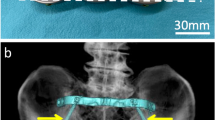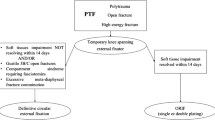Abstract
Background
Transverse posterior wall fractures are difficult to treat and historically have been associated with stiffness, posttraumatic arthritis, and pain, which correlate with the reduction. The Kocher–Langenbeck approach is used most often, whereas the extended iliofemoral approach has been reserved for more complex injury patterns. The latter approach has substantially more risks. No data to our knowledge exist on the use of sequential anterior and posterior approaches for this pattern.
Questions/purposes
The purpose of this study is to evaluate an algorithmic method to determine the choice of surgical approach(es) for transverse posterior wall fractures. The main question is: will this approach-based algorithm allow for adequate reduction and stabilization to union? Our secondary endpoints were Merle d’Aubigne scores, reoperations, and radiographic sequelae including arthritis, avascular necrosis, and heterotopic ossification.
Methods
A retrospective study was conducted in which patients were drawn from an existing database. The inclusion criterion was transverse posterior wall fractures with adequate imaging treated by one surgeon. All but one patient were treated within 2 weeks of injury. Mean followup was 23 months (range, 3 months to 11 years). Between November 5, 1999, and August 22, 2012, 74 patients were treated with open reduction internal fixation for this injury; nine were excluded as a result of percutaneous treatment or inadequate preoperative imaging. The remaining 65 patients (88%) comprised the study group. All patients were treated by the senior surgeon with an algorithm that consisted of either a Kocher–Langenbeck or sequential approach based on the location, magnitude, and direction of displacement of the ischiopubic segment. Indomethacin was prescribed to all patients for heterotopic ossification prophylaxis for a total of 6 weeks postoperatively. Based on the algorithm, 82% (53 patients) were treated with Kocher–Langenbeck and 18% (12 patients) with the sequential approach. Adequacy of reduction was measured using AP and Judet views of the pelvis; union was determined empirically by pain-free weightbearing and lack of displacement over time. Outcomes were the Merle d’Aubigne score and radiographic findings of avascular necrosis or arthrosis.
Results
The algorithm resulted in 100% reduction within 1 mm on plain radiographs. Initial displacement was greater in the patients undergoing the sequential approach (p = 0.01, 7.7 versus 12.4 mm). The average d’Aubigne score was 15.3. Radiographic arthritis scores were 68% excellent/good. Avascular necrosis developed in five patients (8%). Five patients (8%) went on to THA, and four patients (6%) developed superficial or deep infection. Only one patient developed Brooker III heterotopic ossification and this was not symptomatic.
Conclusions
This algorithm helps guide appropriate selection of the surgical approach and results in accurate reduction with functional and radiographic results that are comparable with existing series while avoiding extended approaches. However, like any operative decision, the choice of approach should not depend entirely on an algorithm; rather, the algorithm is best used as a guide to understand the factors involved in treating these rare and complex injuries and to help make an appropriate choice for an individual patient.
Level of Evidence
Level IV, case series. See the Guidelines for Authors for a complete description of levels of evidence.


Similar content being viewed by others
References
Gansslen A, Hildebrand F, Cretek C. Transverse + posterior wall fractures of the acetabulum: epidemiology, operative management and long-term results. Acta Chir Orthop Traumatol Cech. 2013;80:27–33.
Letournel E, Judet R. Fractures of the Acetabulum. 2nd ed. New York, NY, USA: Springer; 1993.
Matta JM. Operative treatment of acetabular fractures through the ilioinguinal approach: a 10-year perspective. Clin Orthop Relat Res. 1994;305:10–19.
Matta JM. Fractures of the acetabulum: accuracy of reduction and clinical results in patients managed operatively within 3 weeks after the injury. J Bone Joint Surg Am. 1996;78:1632–1645.
Moed BR, Carr SE, Gruson KI, Watson JT, Craig JG. Computed tomographic assessment of fractures of the posterior wall of the acetabulum after operative treatment. J Bone Joint Surg Am. 2003;85:512–522.
Tannast M, Najibi S, Matta JM. Two to twenty-year survivorship of the hip in 810 patients with operatively treated acetabular fractures. J Bone Joint Surg Am. 2012;94:1559–1567.
Author information
Authors and Affiliations
Corresponding author
Additional information
Each author certifies that he or she, or a member of his or her immediate family, has no funding or commercial associations (eg, consultancies, stock ownership, equity interest, patent/licensing arrangements, etc) that might pose a conflict of interest in connection with the submitted article.
All ICMJE Conflict of Interest Forms for authors and Clinical Orthopaedics and Related Research® editors and board members are on file with the publication and can be viewed on request.
Each author certifies that his or her institution approved the human protocol for this investigation, that all investigations were conducted in conformity with ethical principles of research, and that informed consent for participation in the study was obtained.
About this article
Cite this article
Bogdan, Y., Dwivedi, S. & Tornetta, P. A Surgical Approach Algorithm for Transverse Posterior Wall Fractures Aids in Reduction Quality. Clin Orthop Relat Res 472, 3338–3344 (2014). https://doi.org/10.1007/s11999-014-3634-6
Published:
Issue Date:
DOI: https://doi.org/10.1007/s11999-014-3634-6




